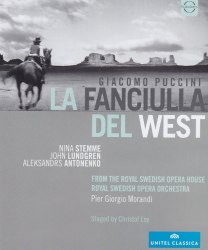|

|
Giacomo PUCCINI (1858-1924)
La fanciulla del West - opera in three acts (1910) [140.00]
Nina Stemme (soprano) - Minnie; Aleksandrs Antonenko (tenor) - Johnson; John Lundgren (baritone) - Rance; John Erik Eleby (bass) - Jake Wallace; Agneta Lundgren (mezzo) - Wowkle; Alar Pintsaar (bass) - Billy Jackrabbit; Niklas Björling Rygert (tenor) - Nick; Karl Rombo (tenor) - Trin; Kristian Flor (tenor) - Happy; Magnus Khyle (tenor) - Joe; Olia Eliasson (baritone) - Sonora; Linus Börjesson (baritone) - Bello; Conny Thimander (baritone) - Harry; Anton Eriksson (baritone) - Castro; Michael Schmidberger (bass) - Ashby; Gunnar Lundberg (bass) - Sid; Ian Power (bass) - Larkens; Jon Nilsson (tenor) - Pony Express rider
Royal Swedish Opera Male Chorus and Orchestra/Pier Giorgio Morandi
rec. Royal Swedish Opera House, February 2012
Director: Hannes Rossacher
Stage Director: Christoph Loy
Picture Format: NTSC
Sound Formats: PCM Stereo; Dolby Digital 5.1
Region Code: 0
Subtitles: Italian, English, German, French, Spanish, Japanese
Booklet Notes: English, German, French
16:9 shot in 1080i HD; stereo and 5.1 surround sound
co-production of BFMI, SVT and Unitel Classica
Reviewed in surround.
EUROARTS 2072594 Blu-ray [140:00]
Of all the opera videos I have seen in recent years, this has the most unexpected opening sequence. In some sort of homage to the classic western, right down to the black and white footage, we see Nina Stemme, kitted out in full Clint Eastwood gear, riding across the plains in, apparently, Monument Valley. She turns and runs full tilt towards the viewer, bursting through the projection screen, for so it turns out to be, onto the stage of Sweden's Royal Opera House and the audience bursts into spontaneous applause before a note is sung. This bizarre opening fits in exactly with the directorial concept for the work which is performed with many additional filmic characteristics, the primary one being the use of projected images of the current action shown in close-up on the back flat of the scenery, again in black & white. Additionally the stage itself is flat and cinemascope-wide and has minimum colour in either scenery or costumes. Entries and exits are left and right and no depth of stage is used. This makes for some awkward moments and a certain amount of traffic congestion. The wooden walls of Minnie's bar appear to have been reused from several previous Scandinavian productions. They strongly reminded me of the Malmö Jenůfa for example. All this fits in quite well with Puccini's exotic use of the language of Westerns: characters regularly greet each other with 'Hello' instead of a more Italianate greeting. In Act 3 one quintet of minor characters sings 'dooda, dooda, day', it makes one wince but it is in the score. There are frequent calls for 'whisky'. Characters are called 'Nick' and 'Johnson' and so on. It all makes La Fanciulla dangerously risible to English-speaking audiences. This might account for its much lower ranking in the Puccini canon. It does not really deserve such a status for a lot of this music is of the highest standard, for all that it lacks the lyrical high points of the preceding Madama Butterfly. Puccini was far from played out with La Rondine, Il Trittico and Turandot still to come. In 1910 when this was first performed, the silent Western was all the rage and this choice of subject would have seemed terribly modern.
The cast, orchestra and conductor have got the work musically right. Not only do Nina Stemme, Aleksandrs Antonenko and John Lundgren sing well - Antonenko much better here than in the recent Otello - but the conductor Pier Giorgio Morandi moulds the score into a beautiful whole. He has the Puccinian 'surge' off to a tee, no wonder, for a man who played in the La Scala orchestra and worked as a conductor alongside luminaries like Muti and Patane, and directed the Rome Opera. So for all the rather plain and monotone staging this is an excellent musical rendering of a splendid piece.
There are other videos, including a classic Covent Garden performance with Neblett and Domingo and the great vinyl recording these two made for DG with a young Zubin Mehta.
It goes without saying these days that the sound and picture are very good and that the menus are the usual user-unfriendly arrangement. The booklet has a useful essay and a detailed track listing with timings.
Dave Billinge
Previous reviews (DVD): Paul Corfield Godfrey & Göran Forsling
 |
 |
|
